Click on an image for detailed information
Click on a column heading to sort in ascending or descending order

My
List |
Addition Date
|
Target
|
Mission
|
Instrument
|
Size
|

|
2017-11-16 |
Sol (our sun)
|
SDO
|
Atmosphere Imaging Assembly
|
1500x1500x3 |
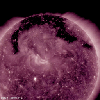
|
-
PIA22113:
-
Coronal Hole All Spread Out

Full Resolution:
TIFF
(4.795 MB)
JPEG
(223.3 kB)
|

|
2017-11-28 |
Sol (our sun)
|
SDO
|
Atmosphere Imaging Assembly
|
1650x1650x3 |
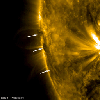
|
-
PIA22120:
-
Churning Filament

Full Resolution:
TIFF
(4.195 MB)
JPEG
(161.9 kB)
|

|
2017-12-11 |
Sol (our sun)
|
SDO
|
Atmosphere Imaging Assembly
|
1630x1632x3 |
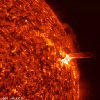
|
-
PIA22123:
-
Slithering Prominence

Full Resolution:
TIFF
(5.042 MB)
JPEG
(264.7 kB)
|

|
2017-12-15 |
Sol (our sun)
|
SDO
|
Atmosphere Imaging Assembly
|
1483x1463x3 |
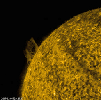
|
-
PIA22195:
-
Prominence Falls Apart

Full Resolution:
TIFF
(4.213 MB)
JPEG
(260.2 kB)
|

|
2017-12-18 |
Sol (our sun)
|
SDO
|
Atmosphere Imaging Assembly
|
1500x1500x3 |
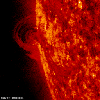
|
-
PIA22196:
-
Curling Prominence

Full Resolution:
TIFF
(3.129 MB)
JPEG
(225.7 kB)
|

|
2017-12-29 |
Sol (our sun)
|
SDO
|
Atmosphere Imaging Assembly
|
1783x1780x3 |
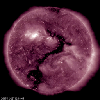
|
-
PIA22197:
-
The Sun Forms a Question

Full Resolution:
TIFF
(5.955 MB)
JPEG
(230.3 kB)
|

|
2018-01-12 |
Sol (our sun)
|
SDO
|
Atmosphere Imaging Assembly
|
1629x1634x3 |
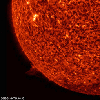
|
-
PIA22198:
-
Small Twisting Prominence

Full Resolution:
TIFF
(4.534 MB)
JPEG
(316.9 kB)
|

|
2018-01-18 |
Sol (our sun)
|
SDO
|
Atmosphere Imaging Assembly
|
1500x1602x3 |

|
-
PIA22199:
-
Reversing Prominence

Full Resolution:
TIFF
(3.541 MB)
JPEG
(214.3 kB)
|

|
2018-01-31 |
Sol (our sun)
|
SDO
|
Atmosphere Imaging Assembly
|
1630x1630x3 |
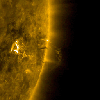
|
-
PIA22184:
-
Small Flare and a Coronal Mass Ejection

Full Resolution:
TIFF
(3.803 MB)
JPEG
(126.8 kB)
|

|
2018-02-07 |
Sol (our sun)
|
SDO
|
Atmosphere Imaging Assembly
|
1500x1500x3 |
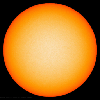
|
-
PIA22242:
-
Spotless Days

Full Resolution:
TIFF
(4.791 MB)
JPEG
(168 kB)
|

|
2018-02-15 |
Sol (our sun)
|
SDO
|
Atmosphere Imaging Assembly
|
1571x1480x3 |
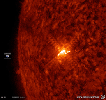
|
-
PIA22244:
-
One Small Flare

Full Resolution:
TIFF
(3.486 MB)
JPEG
(180.6 kB)
|

|
2018-02-16 |
Sol (our sun)
|
SDO
|
Atmosphere Imaging Assembly
|
1650x1627x3 |
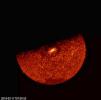
|
-
PIA22259:
-
SDO's Version of an Eclipse
Full Resolution:
TIFF
(1.681 MB)
JPEG
(136.5 kB)
|

|
2018-03-06 |
Sol (our sun)
|
SDO
|
Atmosphere Imaging Assembly
|
1800x1653x3 |
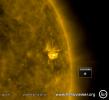
|
-
PIA22260:
-
Small Bursts
Full Resolution:
TIFF
(4.352 MB)
JPEG
(141.5 kB)
|

|
2018-03-19 |
Sol (our sun)
|
SDO
|
Atmosphere Imaging Assembly
|
1708x1620x3 |
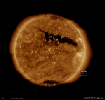
|
-
PIA22345:
-
Elongated Coronal Hole

Full Resolution:
TIFF
(3.231 MB)
JPEG
(125.5 kB)
|

|
2018-04-02 |
Sol (our sun)
|
SDO
|
Atmosphere Imaging Assembly
|
1800x1800x3 |
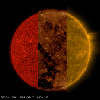
|
-
PIA22360:
-
Wavelength Comparisons

Full Resolution:
TIFF
(5.55 MB)
JPEG
(192.7 kB)
|

|
2018-04-09 |
Sol (our sun)
|
SDO
|
Atmosphere Imaging Assembly
|
1800x1662x3 |
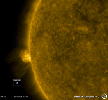
|
-
PIA22411:
-
Wavelength Comparisons

Full Resolution:
TIFF
(5.735 MB)
JPEG
(162.3 kB)
|

|
2018-04-20 |
Sol (our sun)
|
SDO
|
Atmosphere Imaging Assembly
|
1473x1473x3 |
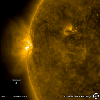
|
-
PIA06676:
-
Small but Dynamic Active Region

Full Resolution:
TIFF
(3.662 MB)
JPEG
(131.2 kB)
|

|
2018-04-23 |
Sol (our sun)
|
SDO
|
Atmosphere Imaging Assembly
|
1500x1493x3 |
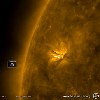
|
-
PIA22430:
-
Active Region Coming Around the Bend

Full Resolution:
TIFF
(3.819 MB)
JPEG
(114.4 kB)
|

|
2018-05-01 |
Sol (our sun)
|
SDO
|
Atmosphere Imaging Assembly
|
1650x1650x3 |

|
-
PIA22449:
-
Tangled Up in Blue

Full Resolution:
TIFF
(6.549 MB)
JPEG
(427.3 kB)
|

|
2018-05-08 |
Sol (our sun)
|
SDO
|
Atmosphere Imaging Assembly
|
1641x1641x3 |
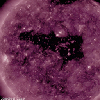
|
-
PIA00624:
-
Coronal Hole Facing Earth

Full Resolution:
TIFF
(6.335 MB)
JPEG
(299.4 kB)
|

|
2018-05-15 |
Sol (our sun)
|
SDO
|
Atmosphere Imaging Assembly
|
1500x1332x3 |
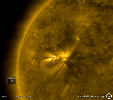
|
-
PIA00577:
-
Coronal Hole Facing Earth

Full Resolution:
TIFF
(3.339 MB)
JPEG
(130 kB)
|

|
2018-05-22 |
Sol (our sun)
|
SDO
|
Atmosphere Imaging Assembly
|
1500x1500x3 |
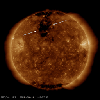
|
-
PIA00575:
-
Coronal Hole Rotating Towards Us

Full Resolution:
TIFF
(3.548 MB)
JPEG
(125 kB)
|

|
2018-05-29 |
Sol (our sun)
|
SDO
|
Atmosphere Imaging Assembly
|
1924x1794x3 |
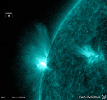
|
-
PIA22461:
-
New Active Region Sputtering with Small Flares

Full Resolution:
TIFF
(7.438 MB)
JPEG
(293.7 kB)
|

|
2018-06-04 |
Sol (our sun)
|
SDO
|
Atmosphere Imaging Assembly
|
1788x1651x3 |
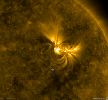
|
-
PIA22475:
-
Dynamic Looping Action

Full Resolution:
TIFF
(4.859 MB)
JPEG
(188 kB)
|

|
2018-06-11 |
Sol (our sun)
|
SDO
|
Atmosphere Imaging Assembly
|
1425x1425x3 |
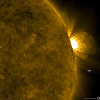
|
-
PIA22508:
-
Ballet of Loops

Full Resolution:
TIFF
(3.74 MB)
JPEG
(131 kB)
|

|
2018-06-26 |
Sol (our sun)
|
SDO
|
Atmosphere Imaging Assembly
|
1800x1567x3 |
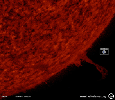
|
-
PIA22537:
-
Evolving Prominence

Full Resolution:
TIFF
(3.348 MB)
JPEG
(199.1 kB)
|

|
2018-07-05 |
Sol (our sun)
|
SDO
|
Atmosphere Imaging Assembly
|
1794x1632x3 |
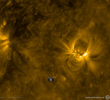
|
-
PIA22582:
-
Rambunctious Active Region

Full Resolution:
TIFF
(4.548 MB)
JPEG
(173.5 kB)
|

|
2018-07-17 |
Sol (our sun)
|
SDO
|
Atmosphere Imaging Assembly
|
1770x1632x3 |
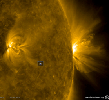
|
-
PIA22589:
-
Festoons of Loops

Full Resolution:
TIFF
(4.784 MB)
JPEG
(157.8 kB)
|

|
2018-07-24 |
Sol (our sun)
|
SDO
|
Atmosphere Imaging Assembly
|
1669x1669x3 |
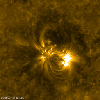
|
-
PIA22645:
-
Detailed Loops Above an Active Region

Full Resolution:
TIFF
(4.775 MB)
JPEG
(171.4 kB)
|

|
2018-07-31 |
Sol (our sun)
|
SDO
|
Atmosphere Imaging Assembly
|
1740x1635x1 |

|
-
PIA22646:
-
An Almost Spotless Record

Full Resolution:
TIFF
(1.411 MB)
JPEG
(157.9 kB)
|

|
2018-08-07 |
Sol (our sun)
|
SDO
|
Atmosphere Imaging Assembly
|
1687x1684x3 |
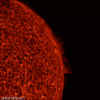
|
-
PIA22661:
-
Twisting Prominences

Full Resolution:
TIFF
(3.843 MB)
JPEG
(231.7 kB)
|

|
2018-08-14 |
Sol (our sun)
|
SDO
|
Atmosphere Imaging Assembly
|
1800x1800x3 |
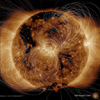
|
-
PIA22662:
-
Magnetic Field Portrayed

Full Resolution:
TIFF
(8.707 MB)
JPEG
(757.2 kB)
|

|
2018-08-20 |
Sol (our sun)
|
SDO
|
Atmosphere Imaging Assembly
|
1498x1500x3 |
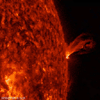
|
-
PIA22673:
-
Twisting Outburst

Full Resolution:
TIFF
(3.898 MB)
JPEG
(196.1 kB)
|

|
2018-09-03 |
Sol (our sun)
|
SDO
|
Atmosphere Imaging Assembly
|
1780x1750x3 |
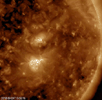
|
-
PIA22680:
-
New Active Region Grows Up

Full Resolution:
TIFF
(6.915 MB)
JPEG
(212.3 kB)
|

|
2018-09-17 |
Sol (our sun)
|
SDO
|
Atmosphere Imaging Assembly
|
1500x1500x3 |
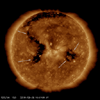
|
-
PIA22722:
-
Emerging Coronal Hole

Full Resolution:
TIFF
(3.545 MB)
JPEG
(135.6 kB)
|

|
2018-09-17 |
Sol (our sun)
|
SDO
|
Atmosphere Imaging Assembly
|
1800x1800x3 |
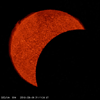
|
-
PIA22723:
-
Double Lunar Transit

Full Resolution:
TIFF
(2.063 MB)
JPEG
(142 kB)
|

|
2018-09-24 |
Sol (our sun)
|
SDO
|
Atmosphere Imaging Assembly
|
1800x1800x3 |
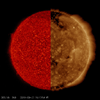
|
-
PIA22724:
-
Two Wavelengths, Two Different Images

Full Resolution:
TIFF
(5.585 MB)
JPEG
(262.9 kB)
|

|
2018-10-17 |
Sol (our sun)
|
SDO
|
Atmosphere Imaging Assembly
|
1668x1668x3 |
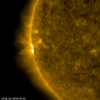
|
-
PIA18139:
-
Sole Active Region in Profile

Full Resolution:
TIFF
(4.272 MB)
JPEG
(150.1 kB)
|

|
2018-10-29 |
Sol (our sun)
|
SDO
|
Atmosphere Imaging Assembly
|
1770x1765x3 |
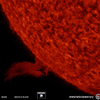
|
-
PIA18140:
-
Eruptive Prominence

Full Resolution:
TIFF
(3.695 MB)
JPEG
(240.5 kB)
|

|
2018-11-12 |
Sol (our sun)
|
SDO
|
Atmosphere Imaging Assembly
|
1445x1445x3 |
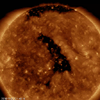
|
-
PIA18141:
-
Central Coronal Hole

Full Resolution:
TIFF
(4.566 MB)
JPEG
(155.4 kB)
|

|
2018-11-14 |
Sol (our sun)
|
SDO
|
Atmosphere Imaging Assembly
|
1628x1587x3 |
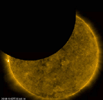
|
-
PIA18142:
-
SDO Observes a Partial Lunar Eclipse

Full Resolution:
TIFF
(3.473 MB)
JPEG
(139.1 kB)
|

|
2018-11-19 |
Sol (our sun)
|
SDO
|
Atmosphere Imaging Assembly
|
1800x1800x3 |
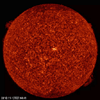
|
-
PIA18143:
-
Opposing Solar Prominences

Full Resolution:
TIFF
(5.168 MB)
JPEG
(372.5 kB)
|

|
2018-12-05 |
Sol (our sun)
|
SDO
|
Atmosphere Imaging Assembly
|
1500x1500x3 |
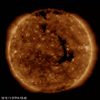
|
-
PIA18144:
-
Reappearing Coronal Hole

Full Resolution:
TIFF
(4.192 MB)
JPEG
(145.1 kB)
|

|
2018-12-11 |
Sol (our sun)
|
SDO
|
Atmosphere Imaging Assembly
|
1650x1650x3 |
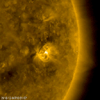
|
-
PIA21211:
-
Solar Active Region's Cameo Appearance

Full Resolution:
TIFF
(4.752 MB)
JPEG
(146 kB)
|

|
2018-12-24 |
Sol (our sun)
|
SDO
|
Atmosphere Imaging Assembly
|
1800x1800x3 |
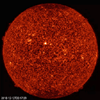
|
-
PIA21212:
-
Small Prominences

Full Resolution:
TIFF
(5.751 MB)
JPEG
(400 kB)
|

|
2019-02-19 |
Sol (our sun)
|
SDO
|
Atmosphere Imaging Assembly
|
1650x1540x3 |
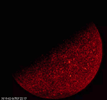
|
-
PIA21213:
-
Spring 2019 Eclipse Season Arrives

Full Resolution:
TIFF
(2.94 MB)
JPEG
(152.9 kB)
|

|
2019-03-04 |
Sol (our sun)
|
SDO
|
Atmosphere Imaging Assembly
|
1520x1500x3 |
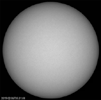
|
-
PIA21218:
-
Spotless February

Full Resolution:
TIFF
(1.689 MB)
JPEG
(190.5 kB)
|

|
2019-03-11 |
Sol (our sun)
|
SDO
|
Atmosphere Imaging Assembly
|
1500x1414x3 |
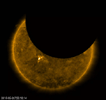
|
-
PIA21905:
-
Criss-Crossing Lunar Transit

Full Resolution:
TIFF
(2.274 MB)
JPEG
(92.56 kB)
|

|
2007-04-27 |
Sol (our sun)
|
Solar TErrestrial RElations Observatory (STEREO)
|
SECCHI/Extreme Ultraviolet Imaging Telescope
|
1920x1080x3 |
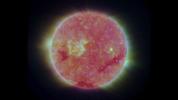
|
-
PIA09320:
-
Full Disk Image of the Sun, March 26, 2007
Full Resolution:
TIFF
(6.23 MB)
JPEG
(110.4 kB)
|

|
2007-04-27 |
Sol (our sun)
|
Solar TErrestrial RElations Observatory (STEREO)
|
SECCHI/Extreme Ultraviolet Imaging Telescope
|
1920x1080x3 |
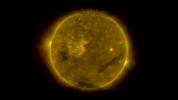
|
-
PIA09321:
-
Full Disk Image of the Sun, March 26, 2007 (Anaglyph)
Full Resolution:
TIFF
(6.23 MB)
JPEG
(91.3 kB)
|

|
2007-04-27 |
Sol (our sun)
|
Solar TErrestrial RElations Observatory (STEREO)
|
SECCHI/Extreme Ultraviolet Imaging Telescope
|
1920x1080x3 |
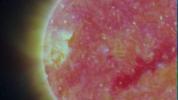
|
-
PIA09322:
-
Close-up View of an Active Region of the Sun, March 23, 2007
Full Resolution:
TIFF
(6.23 MB)
JPEG
(116 kB)
|

|
2007-04-27 |
Sol (our sun)
|
Solar TErrestrial RElations Observatory (STEREO)
|
SECCHI/Extreme Ultraviolet Imaging Telescope
|
1920x1080x3 |
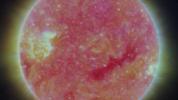
|
-
PIA09324:
-
Closer View of the Equatorial Region of the Sun, March 24, 2007
Full Resolution:
TIFF
(6.23 MB)
JPEG
(129.6 kB)
|

|
2007-04-27 |
Sol (our sun)
|
Solar TErrestrial RElations Observatory (STEREO)
|
SECCHI/Extreme Ultraviolet Imaging Telescope
|
1920x1080x3 |
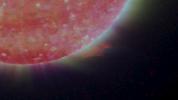
|
-
PIA09326:
-
Right Limb of the South Pole of the Sun, March 18, 2007
Full Resolution:
TIFF
(6.23 MB)
JPEG
(85.81 kB)
|

|
2007-04-27 |
Sol (our sun)
|
Solar TErrestrial RElations Observatory (STEREO)
|
SECCHI/Extreme Ultraviolet Imaging Telescope
|
1920x1080x3 |
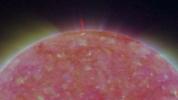
|
-
PIA09328:
-
North Pole of the Sun, March 20, 2007
Full Resolution:
TIFF
(6.23 MB)
JPEG
(94.86 kB)
|

|
2007-04-27 |
Sol (our sun)
|
Solar TErrestrial RElations Observatory (STEREO)
|
SECCHI/Extreme Ultraviolet Imaging Telescope
|
1920x1080x3 |
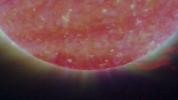
|
-
PIA09330:
-
South Pole of the Sun, March 20, 2007
Full Resolution:
TIFF
(6.23 MB)
JPEG
(94.62 kB)
|

|
2007-04-27 |
Sol (our sun)
|
Solar TErrestrial RElations Observatory (STEREO)
|
SECCHI/Extreme Ultraviolet Imaging Telescope
|
1920x1080x3 |
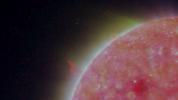
|
-
PIA09332:
-
Left Limb of North Pole of the Sun, March 20, 2007
Full Resolution:
TIFF
(6.23 MB)
JPEG
(84.33 kB)
|

|
2007-04-27 |
Sol (our sun)
|
Solar TErrestrial RElations Observatory (STEREO)
|
SECCHI/Extreme Ultraviolet Imaging Telescope
|
1920x1080x3 |
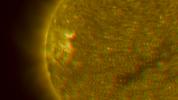
|
-
PIA09323:
-
Close-up View of an Active Region of the Sun, March 23, 2007 (Anaglyph)
Full Resolution:
TIFF
(6.23 MB)
JPEG
(145.6 kB)
|

|
2007-04-27 |
Sol (our sun)
|
Solar TErrestrial RElations Observatory (STEREO)
|
SECCHI/Extreme Ultraviolet Imaging Telescope
|
1920x1080x3 |
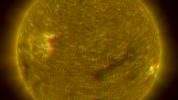
|
-
PIA09325:
-
Closer View of the Equatorial Region of the Sun, March 24, 2007 (Anaglyph)
Full Resolution:
TIFF
(6.23 MB)
JPEG
(169.6 kB)
|

|
2007-04-27 |
Sol (our sun)
|
Solar TErrestrial RElations Observatory (STEREO)
|
SECCHI/Extreme Ultraviolet Imaging Telescope
|
1920x1080x3 |
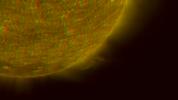
|
-
PIA09327:
-
Right Limb of the South Pole of the Sun, March 18, 2007 (Anaglyph)
Full Resolution:
TIFF
(6.23 MB)
JPEG
(99.1 kB)
|

|
2007-04-27 |
Sol (our sun)
|
Solar TErrestrial RElations Observatory (STEREO)
|
SECCHI/Extreme Ultraviolet Imaging Telescope
|
1920x1080x3 |
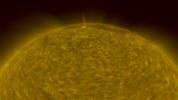
|
-
PIA09329:
-
North Pole of the Sun, March 20, 2007 (Anaglyph)
Full Resolution:
TIFF
(6.23 MB)
JPEG
(126.2 kB)
|

|
2007-04-27 |
Sol (our sun)
|
Solar TErrestrial RElations Observatory (STEREO)
|
SECCHI/Extreme Ultraviolet Imaging Telescope
|
1920x1080x3 |
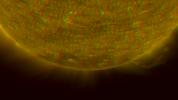
|
-
PIA09331:
-
South Pole of the Sun, March 20, 2007 (Anaglyph)
Full Resolution:
TIFF
(6.23 MB)
JPEG
(114.9 kB)
|

|
2007-04-27 |
Sol (our sun)
|
Solar TErrestrial RElations Observatory (STEREO)
|
SECCHI/Extreme Ultraviolet Imaging Telescope
|
1920x1080x3 |
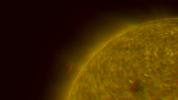
|
-
PIA09333:
-
Left Limb of North Pole of the Sun, March 20, 2007 (Anaglyph)
Full Resolution:
TIFF
(6.23 MB)
JPEG
(89.44 kB)
|

|
1996-09-13 |
Sol (our sun)
|
Voyager
|
VG ISS - Wide Angle
|
3430x2650x3 |
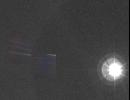
|
-
PIA00450:
-
Solar System Portrait - View of the Sun, Earth and Venus
Full Resolution:
TIFF
(8.676 MB)
JPEG
(515.8 kB)
|

|
1996-09-13 |
Sol (our sun)
|
Voyager
|
VG ISS - Wide Angle
|
4000x1200x3 |

|
-
PIA00451:
-
Solar System Portrait - 60 Frame Mosaic
Full Resolution:
TIFF
(1.124 MB)
JPEG
(166.4 kB)
|

|
2003-12-12 |
Sol (our sun)
|
Voyager
|
|
576x389x3 |
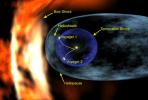
|
-
PIA04927:
-
Voyager Approaches Final Frontier (Artist's Concept)
Full Resolution:
TIFF
(598.8 kB)
JPEG
(25.05 kB)
|

|
2011-12-16 |
Sol (our sun)
|
Voyager
|
|
1280x720x3 |
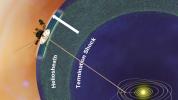
|
-
PIA15176:
-
Low-Energy Particles Leaking out of the Solar System (Artist's Concept)
Full Resolution:
TIFF
(2.768 MB)
JPEG
(130.8 kB)
|

|
2011-12-16 |
Sol (our sun)
|
Voyager
|
|
1280x720x3 |
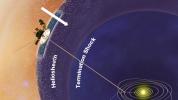
|
-
PIA15177:
-
Energetic Particles from Outside our Solar System Increase (Artist's Concept)
Full Resolution:
TIFF
(2.768 MB)
JPEG
(103.7 kB)
|

|
2011-12-16 |
Sol (our sun)
|
Voyager
|
|
1280x720x3 |
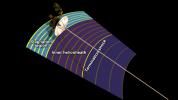
|
-
PIA15178:
-
Magnetic Field Lines Intensifying (Artist's Concept)
Full Resolution:
TIFF
(2.768 MB)
JPEG
(61.26 kB)
|

|
2011-12-16 |
Sol (our sun)
|
Voyager
|
|
1281x718x3 |
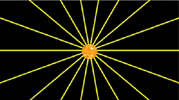
|
-
PIA15179:
-
The Sun's Magnetic Field

Full Resolution:
TIFF
(2.762 MB)
JPEG
(76.94 kB)
|

|
2012-12-03 |
Sol (our sun)
|
Voyager
|
Magnetometer
|
2006x1479x3 |
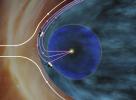
|
-
PIA16482:
-
The Sun's Southern Wind Flows Northward (Artist's Concept)
Full Resolution:
TIFF
(8.904 MB)
JPEG
(151.9 kB)
|

|
2012-12-03 |
Sol (our sun)
|
Voyager
|
|
1772x975x3 |
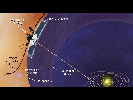
|
-
PIA16483:
-
Plasma Flow Near Voyager 1 (Artist Animation)

Full Resolution:
TIFF
(1.731 MB)
JPEG
(117.8 kB)
|

|
2012-12-03 |
Sol (our sun)
|
Voyager
|
|
1000x973x3 |
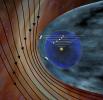
|
-
PIA16485:
-
Solar and Interstellar Magnetic Fields (Artist's Concept)
Full Resolution:
TIFF
(2.92 MB)
JPEG
(98.65 kB)
|

|
2012-12-03 |
Sol (our sun)
|
Voyager
|
|
1280x720x3 |
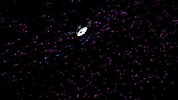
|
-
PIA16486:
-
Voyager 1 Explores the "Magnetic Highway"

Full Resolution:
TIFF
(2.766 MB)
JPEG
(61.38 kB)
|

|
2013-02-12 |
Sol (our sun)
|
Voyager
|
|
1280x730x3 |
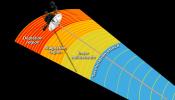
|
-
PIA16734:
-
Magnetic Field Line Pile-Up (Artist's Concept)
Full Resolution:
TIFF
(2.804 MB)
JPEG
(85 kB)
|

|
2013-06-27 |
Sol (our sun)
|
Voyager
|
|
1385x1103x3 |
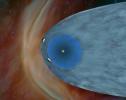
|
-
PIA17033:
-
Voyagers in the Heliosheath (Cropped)
Full Resolution:
TIFF
(4.585 MB)
JPEG
(80.83 kB)
|

|
2013-06-27 |
Sol (our sun)
|
Voyager
|
|
1280x730x3 |
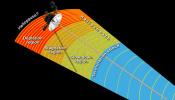
|
-
PIA17034:
-
Transitional Regions at the Heliosphere's Outer Limits
Full Resolution:
TIFF
(2.804 MB)
JPEG
(110 kB)
|

|
2013-09-12 |
Sol (our sun)
|
Voyager
|
Plasma Wave Instrument
|
1280x720x3 |
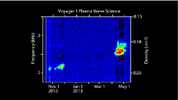
|
-
PIA17045:
-
Voyager Captures Sounds of Interstellar Space

Full Resolution:
TIFF
(2.766 MB)
JPEG
(56.6 kB)
|

|
2013-09-12 |
Sol (our sun)
|
Voyager
|
|
5432x3025x3 |
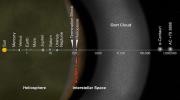
|
-
PIA17046:
-
Voyager Goes Interstellar (Artist Concept)
Full Resolution:
TIFF
(49.32 MB)
JPEG
(3.534 MB)
|

|
2013-09-12 |
Sol (our sun)
|
Voyager
|
Very Long Baseline Array
|
512x512x3 |
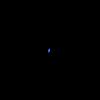
|
-
PIA17047:
-
Voyager Signal Spotted By Earth Radio Telescopes
Full Resolution:
TIFF
(264.2 kB)
JPEG
(4.896 kB)
|

|
2013-09-12 |
Sol (our sun)
|
Voyager
|
|
1280x720x3 |
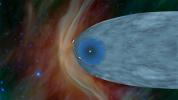
|
-
PIA17048:
-
One Voyager Out, One Voyager In (Artist Concept)
Full Resolution:
TIFF
(2.766 MB)
JPEG
(65.1 kB)
|

|
2013-09-12 |
Sol (our sun)
|
Voyager
|
|
1280x720x3 |
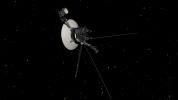
|
-
PIA17049:
-
Voyager in Space (Artist Concept)
Full Resolution:
TIFF
(2.766 MB)
JPEG
(35.7 kB)
|

|
2013-09-12 |
Sol (our sun)
|
Voyager
|
|
1280x720x3 |
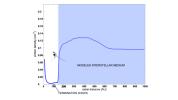
|
-
PIA17441:
-
Observed Change in Density Shows Voyager is in Interstellar Space
Full Resolution:
TIFF
(2.766 MB)
JPEG
(44.37 kB)
|

|
2013-09-12 |
Sol (our sun)
|
Voyager
|
|
1280x720x3 |
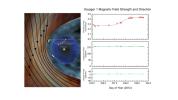
|
-
PIA17442:
-
Mystery of the Interstellar Magnetic Field (Artist's Concept)
Full Resolution:
TIFF
(2.766 MB)
JPEG
(78.79 kB)
|

|
2013-09-12 |
Sol (our sun)
|
Voyager
|
|
1280x720x3 |
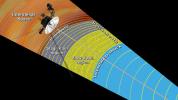
|
-
PIA17460:
-
Moving into Interstellar Space (Artist Concept)
Full Resolution:
TIFF
(2.766 MB)
JPEG
(120.1 kB)
|

|
2013-09-12 |
Sol (our sun)
|
Voyager
|
Oschin Schmidt Telescope
|
891x893x1 |
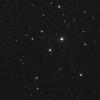
|
-
PIA17461:
-
Heading toward Gliese 445
Full Resolution:
TIFF
(796.7 kB)
JPEG
(105.7 kB)
|

|
2013-09-12 |
Sol (our sun)
|
Voyager
|
|
8192x4610x3 |
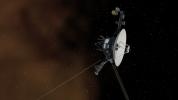
|
-
PIA17462:
-
Voyager 1 Entering Interstellar Space (Artist Concept)
Full Resolution:
TIFF
(113.3 MB)
JPEG
(938.1 kB)
|

|
2013-09-12 |
Sol (our sun)
|
Voyager
|
|
1280x720x3 |
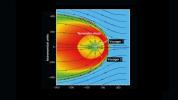
|
-
PIA17463:
-
Heliosphere Traveling Through Interstellar Space
Full Resolution:
TIFF
(2.766 MB)
JPEG
(72.59 kB)
|